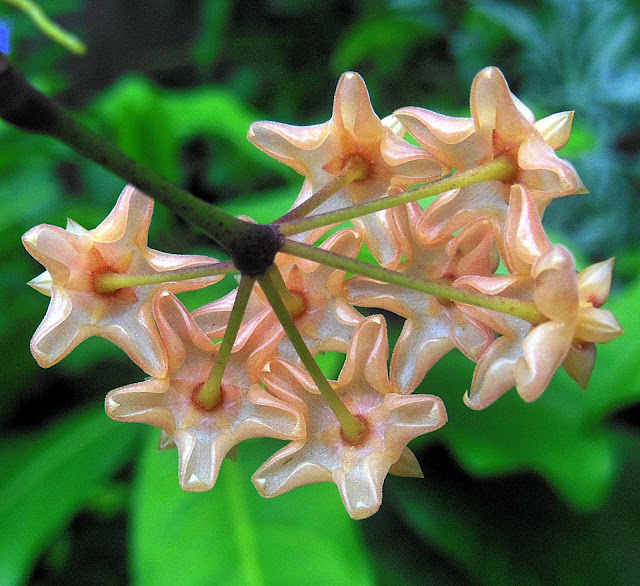A puzzling Hoya from I-can't-remember-where
One of my almost never-ending woes in the garden, apart from leaf-eating pests, is the tags' writings, which become obscured over time to render them useless. With plants that go dormant, this can be annoying, but once these plants have come out of their dormancy, then their identification can be determined. Not so for the other plants. Even more so for similar-looking ones. And that, ladies and gents, is my conundrum for today.
I may have been keeping this plant for some years now, as I have photos of it from its previous flowerings. But for the life of me, I cannot pin it down to provenance. The tag hanging from its pot, is one of those that I started using during my heydays of going to the forests of Visayas, so this could have come either from Leyte or Samar. However, I also have this practice of recycling plant tags. A face-palmable moment, indeed.
And so I have NO idea where I got this one.
The flowers and leaves places it within a group of hoyas centered around H. camphorifolia, which appears to be confined to the Philippines. Their leaves often have very thin, pale-colored veins that appear like lace work:
If you look really closely, you might see those very tiny hairs (the nerdy, botanical term is 'trichomes') covering the corolla. The 'stars' sitting above are the corona lobes.
The plant does not produce a lot of flowers, but the individual blooms are larger than most from the camphorifolia group, being around 1.2 cm across. The fragrance is what I would often call 'soft', but quite faint. The flowers of H. camphorifolia, by comparison, smell sourish.
And just to throw you a bit off-balanced, this plant is similar to ANOTHER plant:
However, the plant above produces more flowers, with corollas that are wider; if I remember it correctly, those corollas do not have the microscopic hairs either. Ask me not what it is- I have no idea either. It may be the same species as above, but I will need to coax myself into becoming a botanist again. I have already retired, you see.
But going back... The flowers fade in coloration by afternoon. A great number of hoyas do not undergo this ontogenetic color change as their flowers age. Hmmm....
From the rear, you can see how the corolla margins reflex. Many Hoya flowers do this. The tiny 'star' behind each corolla is called the 'calyx'.
Lookee that. Hoya flowers are actually almost a collection of star-shaped patterns:
For all I know, this plant probably has a name already. But I am not too interested in most Hoya literature published these days, particularly the Kloppenburgian ones. I would, however, highly appreciate if you can offer some leads or suggestions regarding its identity. And since I probably have only one of this plant, I may need to get my secateurs ready for some serious propagating.













This comment has been removed by the author.
ReplyDeleteIt is the back picture i love the most. I wonder why of all whys, i have not taken a back picture of my H. benguetensis.
ReplyDeleteThose rear habits of the corollas surely serve some taxonomic relevance. I remember using that argument as one of the strengths of Hoya cutis-porcelana as a unique species.
ReplyDelete